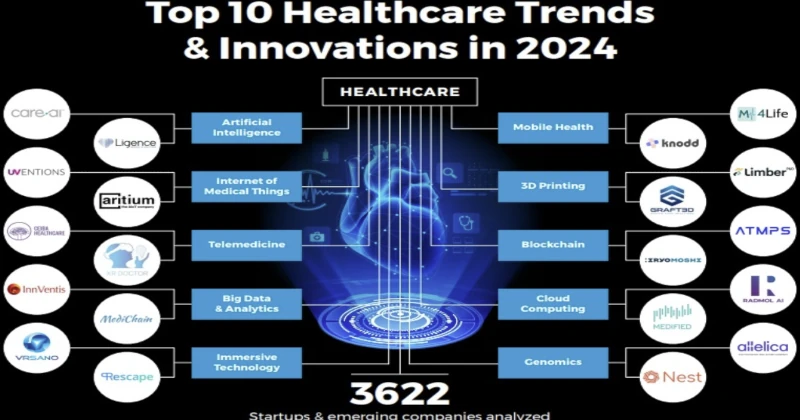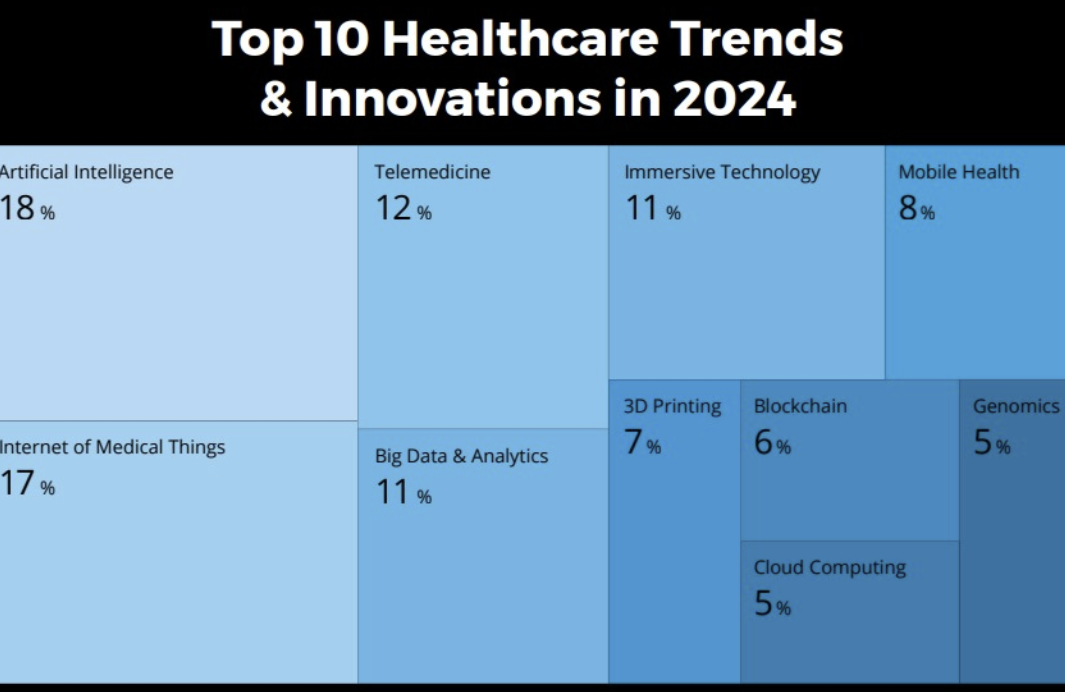Healthcare industry trends that we witness today are new technologies and solutions that address the requirements for clinical diagnosis, treatment, and disease management. The global Covid-19 pandemic led to an upsurge in technologies for disinfecting, limiting transmission, detecting disease spread, as well as for treatment, patient management, and immunisation. The advancements in the healthcare industry range from e-consultations, telemedicine, real-time diagnosis to accessing digital therapeutics provided by immersion technology tools.
Technology advancements in healthcare like genetic analysis, clinical data storage, and big data and analytics enable the development of precision medicine. Startups customise treatment planning and execution for individual patients using real-time, remote monitoring devices. The adoption of artificial intelligence (AI), the internet of things (IoT), and data management practices is making hospitals smarter. These solutions enhance workflows and staff scheduling and provide connected infrastructure, devices, and systems to accelerate accurate and equitable clinical services.
In the Innovation Map below, you get an overview of the Top 10 Healthcare Industry Trends and Innovations that impact healthcare companies worldwide.

Impact of the Top 10 Healthcare Industry Trends
HealthTech startups employ AI and the internet of medical things (IoMT) for real-time, continuous, and remote monitoring of patients. Telemedicine solutions enhance accessibility to clinical services for patients unable to visit hospitals frequently. Big data and analytics solutions process structured and unstructured medical data and biomedical literature to generate novel insights.
Virtual reality (VR), augmented reality (AR), and mixed reality (MR) allow MedTech startups to develop enhanced digital therapy experiences. 3D Printing, particularly bioprinting, enables the development of quality prosthetics and organ transplants while reducing the risk of graft rejection.
With the growth of digitization in healthcare, blockchain and cloud computing technologies play a major role in clinical data collection, storage, and exchange.
Lastly, developments in genomics, nanomedicine, and regenerative medicine are advancing personalised healthcare.
Healthcare AI
Artificial intelligence is advancing the healthcare industry by replacing traditional, labor-intensive processes with swift, remote, and real-time solutions for diagnosis, treatment, and disease prevention. HealthTech startups are developing software platforms, APIs, and digital products to harness AI’s potential. Key applications include clinical workflow management, where AI streamlines patient care coordination and administrative tasks.
Internet of Medical Things (IoMT)
IoMT is instrumental for the development of products that need less or no human interaction to provide healthcare services. Connected medical devices, equipment, and infrastructure enable multiple applications like automatic disinfection, smart diagnosis, and remote patient management to name a few. Cognitive IoMT (CIoMT) is a recent subtrend that integrates sensory information, automatic processing, and communication through networks for real-time diagnosis, monitoring, tracking, and disease control.
Telemedicine
The COVID-19 pandemic accelerated the adoption of telemedicine by many governments, healthcare systems, clinicians, and patients. To tackle the pandemic, governments issued telemedicine guidelines to decongest healthcare facilities. Telemedicine minimises the load on facilities and reduces the use of personal protective equipment (PPE) as medical practitioners reach their patients via telecommunication. HealthTech startups are working on telehealth services that facilitate public health mitigation strategies by increasing social distancing. Telemedicine also aids to assist elderly people remotely, reduces bed space, and conserves clinical supplies.
Big Data & Healthcare Analytics
Digitization is transforming medical data collection, storage, diagnostic techniques, treatment planning, surgical workflows, remote patient monitoring, and consultations. The volume of health and medical data is expected to increase exponentially in the coming years. MedTech startups leverage big data and analytics to analyze the unstructured and huge volumes of medical data. It improves the patient-based services, detects diseases earlier, and generates new insights into disease mechanisms. Moreover, big data solutions monitor the quality of processes at healthcare institutions, as well as enable better treatment methods.
Immersive Technology
The use of immersive technologies, such as AR/VR and MR, is on the rise in the healthcare sector. Applications for VR in healthcare vary from rehabilitation therapy and exposure therapy anxiety disorders to aiding in cognitive and physical rehabilitation. AR/VR also plays an important role in medical education. Immersive technologies also find applications in surgery, for instance for the perioperative projection of patient information, holographic images, and scans.
Mobile Health (mHealth)
mHealth technologies provide access to personalised information using digital solutions and connected devices. Mobile devices enable visualisation of health issues that prevent patient commitment. Unconstrained by geographical boundaries and using real-time data streams, smartphone-linked wearable sensors, point-of-need diagnostic devices, and medical-grade imaging make healthcare delivery more equitable and accessible. mHealth solutions played a critical role in controlling the spread of the COVID-19 pandemic by enabling contact tracing, surveillance, quarantine control and management, testing, and dissemination of relevant information, as well as immunization cycle tracking and notification.
3D Printing in Healthcare
3D printing is gaining traction in the healthcare industry for multiple applications like printing lightweight prosthetics, bionics, and casts for fracture repair. The use of inexpensive, lightweight biomaterials and smart materials ensures improvement in care delivery and time of production while reducing costs. 3D printing technologies are advancing the development of patient-specific models of organs and surgical tools, using the patient’s own medical imaging. Another area of application includes personalized surgical instruments that increase a surgeon’s dexterity and support better surgery outcomes while facilitating faster and less traumatic procedures.
Blockchain Technology
The security and traceability of blockchain make the technology suitable for multiple applications in the healthcare industry. Some of these include electronic medical records, remote patient monitoring, pharmaceutical supply chain, and health insurance claims. Blockchain technology supports the management of EHRs and FHIRChain (Fast Health Interoperability Records) for sharing clinical data. It also plays an important role in smart contracts, tackling drug counterfeiting, as well as storing, sharing, and retrieving remotely collected biomedical data.
Cloud Computing and Healthcare
Cloud computing allows clinicians to establish quality patient journeys supported by tech-enabled care delivery via telehealth and remote monitoring. It allows for greater storage capabilities and processing power for data analytics and eliminates the need for on-premise storage. Cloud platforms integrate network, security, billing, monitoring, and alerts, together with access and identity management. It also provides streamlined data access, data storage and management, data backup and recovery, smart data potential, and data interoperability, among others.
Genomics
There have been notable efforts in developing genomics tools for various applications in recent times. Integration of both genomic knowledge and genomic processes into existing clinical workflows would ensure physicians perform established communication and actionable recommendations that a genomic test can provide to patients. The new arena of personalized medicine is possible due to the advent of innovations in genomics. Gene therapy and gene-based therapy solutions have revolutionized clinical medicine and specialty care for several unmet clinical needs.
Tree Map as shown below in the image reveals the Impact of the Top 10 Healthcare Industry Trends.

Challenges faced while implementing emerging technologies in Healthcare Sector and how to overcome them:
Digital transformation can impact all facets of healthcare, from facilitating better access to care to enhancing the quality and lowering costs.
With the growth of digitization in healthcare, blockchain and cloud computing technologies play a major role in clinical data collection, storage, and exchange.
The healthcare industry is facing several challenges in implementing emerging technologies like Cloud, IoT, AI, Big Data Analytics, Cybersecurity, Nanotechnology, Blockchain, Robotics, Automation, Industry 4.0, Industry 5.0 and Digital Transformation.
Some of the challenges are:
Data privacy and security: Healthcare data is sensitive and confidential. The use of emerging technologies increases the risk of data breaches and cyber attacks
Lack of interoperability: Healthcare systems are complex and fragmented. The lack of interoperability between different systems makes it difficult to share data and collaborate
Cost: Implementing emerging technologies requires significant investment in infrastructure, software, and training
Regulatory compliance: Healthcare is a highly regulated industry. Implementing emerging technologies requires compliance with various regulations and standards
Resistance to change: Healthcare professionals may be resistant to change and may not be willing to adopt new technologies.
To overcome these challenges, healthcare organisations need to take a strategic approach to implementing emerging technologies. They need to develop a clear roadmap for implementation that takes into account the unique challenges of the healthcare industry. They also need to invest in training and education to ensure that healthcare professionals are equipped with the skills they need to use these technologies effectively. Finally, they need to work closely with technology vendors and other stakeholders to ensure that emerging technologies are developed with the needs of the healthcare industry in mind.




















Comments